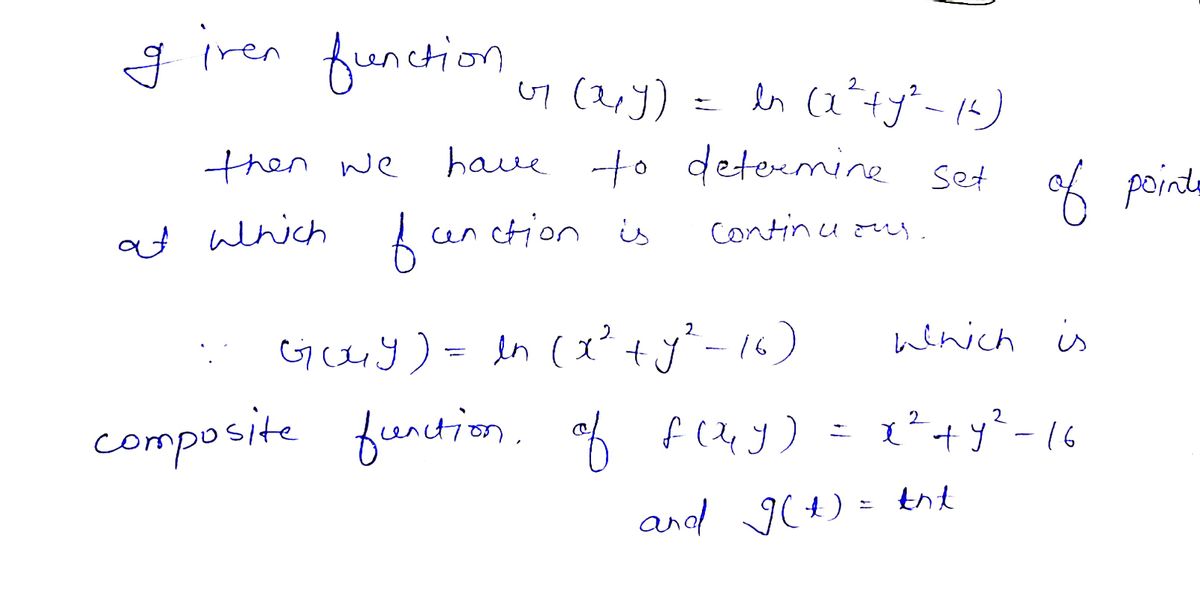Tutorial Exercise Determine the set of points at which the function is continuous. G(x, y) = In(x² + y² - 16) Step 1 The given function G(x, y) = In(x² + y2 - 16) can be thought of as a composition g(f(x, y)). The function f(x, y) = x² + y² - 16 is continuous on its domain {tit 2x1 its domain 2 Submit Skip (y≤ Innot come back) Need Help? Read it {(x, y)| ER}. The function g(t) = In(t)
Tutorial Exercise Determine the set of points at which the function is continuous. G(x, y) = In(x² + y² - 16) Step 1 The given function G(x, y) = In(x² + y2 - 16) can be thought of as a composition g(f(x, y)). The function f(x, y) = x² + y² - 16 is continuous on its domain {tit 2x1 its domain 2 Submit Skip (y≤ Innot come back) Need Help? Read it {(x, y)| ER}. The function g(t) = In(t)
Calculus: Early Transcendentals
8th Edition
ISBN:9781285741550
Author:James Stewart
Publisher:James Stewart
Chapter1: Functions And Models
Section: Chapter Questions
Problem 1RCC: (a) What is a function? What are its domain and range? (b) What is the graph of a function? (c) How...
Related questions
Question
![**Tutorial Exercise**
Determine the set of points at which the function is continuous.
\[ G(x, y) = \ln(x^2 + y^2 - 16) \]
**Step 1**
The given function \( G(x, y) = \ln(x^2 + y^2 - 16) \) can be thought of as a composition \( g(f(x, y)) \).
The function \( f(x, y) = x^2 + y^2 - 16 \) is continuous on its domain \(\{ (x, y) | (x, y) \in \mathbb{R} \}\). The function \( g(t) = \ln(t) \) is continuous on its domain \(\{ t | ? \}\).
There is a dropdown menu with the options:
- \( > \)
- \( \leq \)
- \( < \)
- \( \neq \)
- \( = \)
There is also an input box for entering a value, but the specific selection and value are not visible.
**Note:** The goal is to determine the condition for the domain of \( t \) for which the natural logarithm function \( g(t) = \ln(t) \) remains continuous.
**Need Help?**
There's an option to "Read It" for additional guidance.](/v2/_next/image?url=https%3A%2F%2Fcontent.bartleby.com%2Fqna-images%2Fquestion%2F6147cd51-fae9-4b86-867f-e7a7fe5750a1%2F246f9dd7-c818-4efd-b75f-c12b3508e65c%2F20txfc6_processed.jpeg&w=3840&q=75)
Transcribed Image Text:**Tutorial Exercise**
Determine the set of points at which the function is continuous.
\[ G(x, y) = \ln(x^2 + y^2 - 16) \]
**Step 1**
The given function \( G(x, y) = \ln(x^2 + y^2 - 16) \) can be thought of as a composition \( g(f(x, y)) \).
The function \( f(x, y) = x^2 + y^2 - 16 \) is continuous on its domain \(\{ (x, y) | (x, y) \in \mathbb{R} \}\). The function \( g(t) = \ln(t) \) is continuous on its domain \(\{ t | ? \}\).
There is a dropdown menu with the options:
- \( > \)
- \( \leq \)
- \( < \)
- \( \neq \)
- \( = \)
There is also an input box for entering a value, but the specific selection and value are not visible.
**Note:** The goal is to determine the condition for the domain of \( t \) for which the natural logarithm function \( g(t) = \ln(t) \) remains continuous.
**Need Help?**
There's an option to "Read It" for additional guidance.
Expert Solution
Step 1

Step by step
Solved in 2 steps with 2 images

Recommended textbooks for you

Calculus: Early Transcendentals
Calculus
ISBN:
9781285741550
Author:
James Stewart
Publisher:
Cengage Learning

Thomas' Calculus (14th Edition)
Calculus
ISBN:
9780134438986
Author:
Joel R. Hass, Christopher E. Heil, Maurice D. Weir
Publisher:
PEARSON

Calculus: Early Transcendentals (3rd Edition)
Calculus
ISBN:
9780134763644
Author:
William L. Briggs, Lyle Cochran, Bernard Gillett, Eric Schulz
Publisher:
PEARSON

Calculus: Early Transcendentals
Calculus
ISBN:
9781285741550
Author:
James Stewart
Publisher:
Cengage Learning

Thomas' Calculus (14th Edition)
Calculus
ISBN:
9780134438986
Author:
Joel R. Hass, Christopher E. Heil, Maurice D. Weir
Publisher:
PEARSON

Calculus: Early Transcendentals (3rd Edition)
Calculus
ISBN:
9780134763644
Author:
William L. Briggs, Lyle Cochran, Bernard Gillett, Eric Schulz
Publisher:
PEARSON

Calculus: Early Transcendentals
Calculus
ISBN:
9781319050740
Author:
Jon Rogawski, Colin Adams, Robert Franzosa
Publisher:
W. H. Freeman


Calculus: Early Transcendental Functions
Calculus
ISBN:
9781337552516
Author:
Ron Larson, Bruce H. Edwards
Publisher:
Cengage Learning